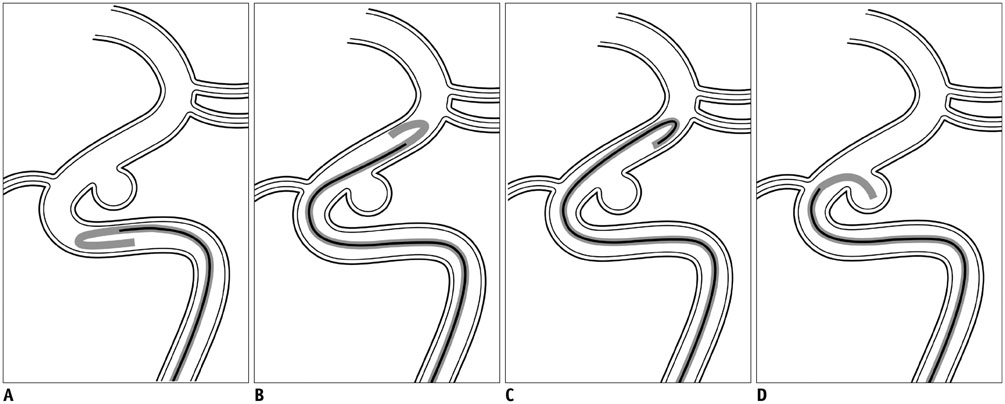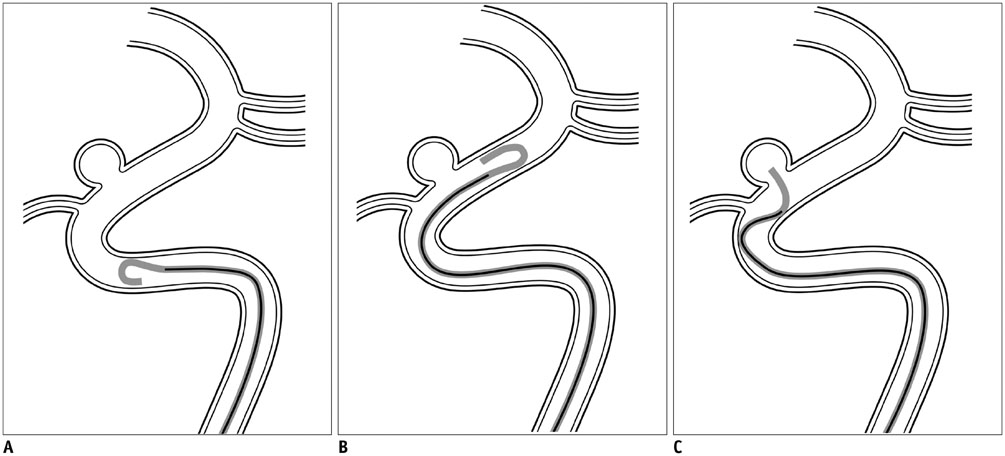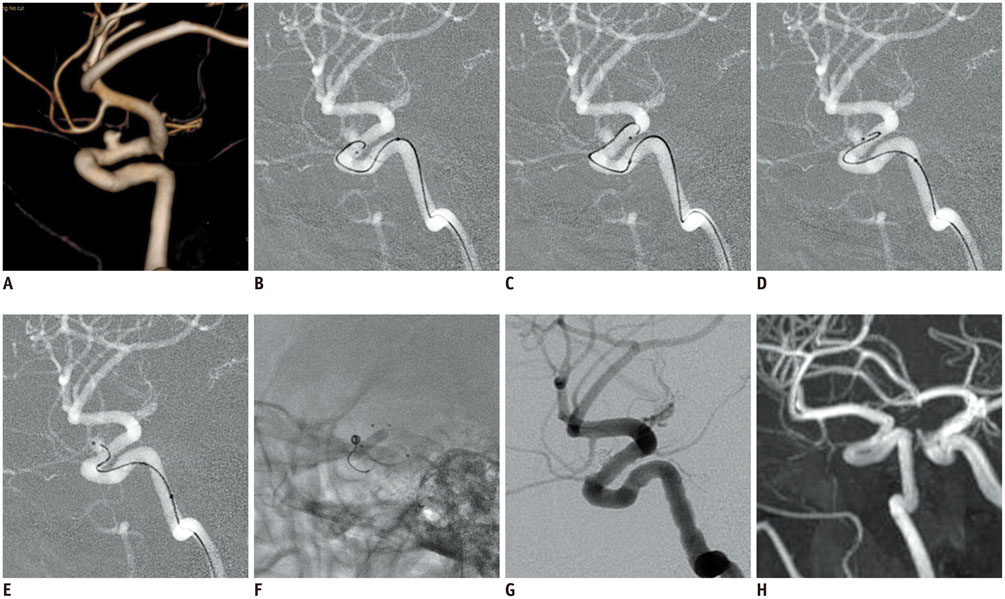Korean J Radiol.
2015 Aug;16(4):899-905. 10.3348/kjr.2015.16.4.899.
Microcatheter Looping to Facilitate Aneurysm Selection in Coil Embolization of Paraclinoid Aneurysms
- Affiliations
-
- 1Department of Radiology, Seoul National University Hospital, Seoul National University College of Medicine, Seoul 110-744, Korea.
- 2Department of Neurosurgery, Seoul National University Hospital, Seoul National University College of Medicine, Seoul 110-744, Korea. hsk4428@yahoo.com
- KMID: 2155565
- DOI: http://doi.org/10.3348/kjr.2015.16.4.899
Abstract
OBJECTIVE
Described herein is a microcatheter looping technique to facilitate aneurysm selection in paraclinoid aneurysms, which remains to be technically challenging due to the inherent complexity of regional anatomy.
MATERIALS AND METHODS
This retrospective study was approved by our Institutional Review Board, and informed consent was waived. Microcatheter looping method was employed in 59 patients with paraclinoid aneurysms between January 2012 and December 2013. In the described technique, construction of a microcatheter loop, which is steam-shaped or pre-shaped, based on the direction of aneurysms, is mandatory. The looped tip of microcatheter was advanced into distal internal carotid artery and positioned atop the target aneurysm. By steering the loop (via inner microguidewire) into the dome of aneurysm and easing tension on the microcatheter, the aneurysm was selected. Clinical and morphologic outcomes were assessed with emphasis on technical aspects of the treatment.
RESULTS
Through this looping technique, a total of 59 paraclinoid aneurysms were successfully treated. After aneurysm selection as described, single microcatheter technique (n = 25) was most commonly used to facilitate coiling, followed by balloon protection (n = 21), stent protection (n = 7), multiple microcatheters (n = 3), and stent/balloon combination (n = 3). Satisfactory aneurysmal occlusion was achieved through coil embolization in 44 lesions (74.6%). During follow-up of 53 patients (mean interval, 10.9 +/- 5.9 months), only one instance (1.9%) of major recanalization was observed. There were no complications related to microcatheter looping.
CONCLUSION
This microcatheter looping method facilitates safe and effective positioning of microcatheter into domes of paraclinoid aneurysms during coil embolization when other traditional microcatheter selection methods otherwise fail.
Keyword
MeSH Terms
Figure
Cited by 1 articles
-
Microcatheter Stabilization Technique Using Partially Inflated Balloon for Coil Embolization of Paraclinoid Aneurysms
Yunsun Song, Boseong Kwon, Abdulrahman Hamad Al-abdulwahhab, Ricky Gusanto Kurniawan, Dae Chul Suh
Neurointervention. 2021;16(2):132-140. doi: 10.5469/neuroint.2021.00185.
Reference
-
1. Wang Y, Li Y, Jiang C, Jiang F, Meng H, Siddiqui AH, et al. Endovascular treatment of paraclinoid aneurysms: 142 aneurysms in one centre. J Neurointerv Surg. 2013; 5:552–556.2. Hoh BL, Carter BS, Budzik RF, Putman CM, Ogilvy CS. Results after surgical and endovascular treatment of paraclinoid aneurysms by a combined neurovascular team. Neurosurgery. 2001; 48:78–89. discussion 89-903. Kwon WH, Jeong HW, Kim ST, Seo JH. Angiographic and clinical result of endovascular treatment in paraclinoid aneurysms. Neurointervention. 2014; 9:83–88.4. Molyneux A, Kerr R, Stratton I, Sandercock P, Clarke M, Shrimpton J, et al. International Subarachnoid Aneurysm Trial (ISAT) of neurosurgical clipping versus endovascular coiling in 2143 patients with ruptured intracranial aneurysms: a randomised trial. Lancet. 2002; 360:1267–1274.5. Wiebers DO, Whisnant JP, Huston J 3rd, Meissner I, Brown RD Jr, Piepgras DG, et al. Unruptured intracranial aneurysms: natural history, clinical outcome, and risks of surgical and endovascular treatment. Lancet. 2003; 362:103–110.6. Cho YD, Sohn CH, Kang HS, Kim JE, Cho WS, Hwang G, et al. Coil embolization of intracranial saccular aneurysms using the Low-profile Visualized Intraluminal Support (LVIS™) device. Neuroradiology. 2014; 56:543–551.7. Cho YD, Kang HS, Kim JE, Son YJ, Lee JY, Lee SJ, et al. Microcatheter looping technique for coil embolization of complex configuration middle cerebral artery aneurysms. Neurosurgery. 2012; 71:1185–1191. discussion 11918. Pierot L, Cognard C, Spelle L, Moret J. Safety and efficacy of balloon remodeling technique during endovascular treatment of intracranial aneurysms: critical review of the literature. AJNR Am J Neuroradiol. 2012; 33:12–15.9. Lee JY, Seo JH, Cho YD, Kang HS, Han MH. Endovascular treatment of wide-neck intracranial aneurysms using a microcatheter protective technique: results and outcomes in 75 aneurysms. AJNR Am J Neuroradiol. 2011; 32:917–922.10. Biondi A, Janardhan V, Katz JM, Salvaggio K, Riina HA, Gobin YP. Neuroform stent-assisted coil embolization of wide-neck intracranial aneurysms: strategies in stent deployment and midterm follow-up. Neurosurgery. 2007; 61:460–468. discussion 468-46911. Lee SJ, Cho YD, Kang HS, Kim JE, Han MH. Coil embolization using the self-expandable closed-cell stent for intracranial saccular aneurysm: a single-center experience of 289 consecutive aneurysms. Clin Radiol. 2013; 68:256–263.12. Kwon BJ, Im SH, Park JC, Cho YD, Kang HS, Kim JE, et al. Shaping and navigating methods of microcatheters for endovascular treatment of paraclinoid aneurysms. Neurosurgery. 2010; 67:34–40. discussion 4013. Kwon BJ, Seo DH, Ha YS, Lee KC. Endovascular Treatment of Wide-necked Cerebral Aneurysms with an Acute Angle Branch Incorporated into the Sac: Novel methods of Branch Access in 8 Aneurysms. Neurointervention. 2012; 7:93–101.14. Kang HS, Kwon BJ, Kim JE, Han MH. Preinterventional clopidogrel response variability for coil embolization of intracranial aneurysms: clinical implications. AJNR Am J Neuroradiol. 2010; 31:1206–1210.15. Roy D, Milot G, Raymond J. Endovascular treatment of unruptured aneurysms. Stroke. 2001; 32:1998–2004.16. Kang HS, Han MH, Kwon BJ, Kwon OK, Kim SH, Choi SH, et al. Short-term outcome of intracranial aneurysms treated with polyglycolic acid/lactide copolymer-coated coils compared to historical controls treated with bare platinum coils: a single-center experience. AJNR Am J Neuroradiol. 2005; 26:1921–1928.17. Ahn JH, Cho YD, Kang HS, Kim JE, Cho WS, Jung SC, et al. Endovascular treatment of ophthalmic artery aneurysms: assessing balloon test occlusion and preservation of vision in coil embolization. AJNR Am J Neuroradiol. 2014; 35:2146–2152.18. Lee WJ, Cho YD, Kang HS, Kim JE, Cho WS, Kim KM, et al. Endovascular coil embolization in internal carotid artery bifurcation aneurysms. Clin Radiol. 2014; 69:e273–e279.19. Cho YD, Lee WJ, Kim KM, Kang HS, Kim JE, Han MH. Endovascular coil embolization of middle cerebral artery aneurysms of the proximal (M1) segment. Neuroradiology. 2013; 55:1097–1102.
- Full Text Links
- Actions
-
Cited
- CITED
-
- Close
- Share
- Similar articles
-
- Microguidewire Looping to Traverse Stented Parent Arteries of Intracranial Aneurysms
- Aneurysm Coil Embolization Using a 1.5-Fr Distal Outer Diameter Microcatheter
- Microcatheter-assisted Coil Embolization of Distal Vertebral Artery Wide-Necked Aneurysm: A Case Report
- Progressive Visual Loss after Endovascular Coiling Treatment of a Large Paraclinoid Aneurysm
- Endovascular Rescue Method for Undesirably Stretched Coil




